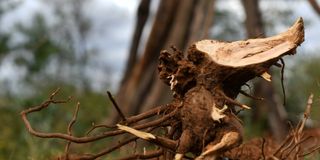Loved to death: Sandalwood tree facing extinction

The root of a sandalwood tree. The tree is uprooted to extract the expensive sandalwood oil, which is found in the roots.
The sweet, earthy fragrance of the sandalwood tree has for many years made it popular and one of the most sought after and most expensive woods in the world.
But its scent is also the reason for its demise as the East African sandalwood is facing extinction.
Despite a 2007 government ban on the harvesting and trading of sandalwood, the trees continue to be cut, mainly for their essential oil, which is extracted to manufacture traditional medicines and cosmetics.
The high demand from Asia for sandalwood drives the trade, said Ngugi Mwangi, CEO of Unganisha Cultures, which focuses on creating awareness on environmental crime.
The whole tree is uprooted to access the sandalwood oil in its roots. A litre of the oil fetches over Sh200,000 on the international market.
“The sandalwood tree is used to make incense sticks, perfumes, candles, soaps and even during cremation. This has made the tree to be considered as “gold” because of its high value,” he says.
There are around 15 different species of the tree, and it is found in South Africa, Zimbabwe, Kenya, Tanzania and Uganda. Other species also grow in India and Australia.
In Kenya, the tree mainly grows in the northern region, with Samburu having the highest number.
Mr Ngugi says illicit traders often go to Samburu and hire locals who can identify male and female sandalwood trees.
“The female tree is more popular because it is believed to have more oil and has a darker red-brown colour, which is more appealing. It also has a sweeter scent than the male tree,” he adds.
Once the trees are cut down, locals are paid around Sh65 per kilogram of wood. Illegal traders make away with the harvested trees in lorries and the wood is sold illegally in Asian markets.

A man digs near a sandalwood tree in a village in Samburu. The tree is facing extinction in Kenya due to illegal trafficking.
“These traffickers can make up to Sh20 million for every 50 tonnes of sandalwood sold. It is a lucrative business that keeps them coming back,” he says.
Improve conservation efforts
Increased demand for sandalwood has made it almost extinct in Kenya.
The over-exploitation goes back to 2006, according to the Convention on International Trade in Endangered Species of Wild Fauna and Flora (CITES), which list the tree as threatened.
Fortunately, not all hope is lost. Mr Ngugi says his team, in conjunction with the Global Initiative against Transnational Organised Crime (GI-TOC), is working to ensure there is more awareness on the illegal trade and to improve conservation efforts.
“We are working with officials from the Kenya Forestry Research Institute (Kefri) to plant more sandalwood tree seedlings across the country. This will go a long way in ensuring the tree does not go extinct,” he said.
Despite these efforts, Mr Ngugi says it is important to ensure no more trees are cut because it takes 10 to 15 years for one tree to reach maturity.
Researchers at Kefri say the future of sandalwood is on-farm domestication. The institute provides seedlings to farmers, who can plant alongside their crops.
This is because the tree grows faster and better through intercropping.
Mr Ngugi says the biggest setback in curbing the illegal trade in sandalwood is corruption.
“Trafficking of sandalwood attracts a jail term of seven years or a fine of Sh500,000, but we see some of the culprits released on bond, cases end up being dropped and in some instances the impounded sandalwood is sold illegally,” he noted.
A report from the Global Tree Assessment shows nearly a third of tree species in the world are facing extinction, with 142 already extinct.
Mr Ngugi says the only way to save the East African sandalwood tree from extinction is by planting more of its seedlings and stopping felling the few remaining ones.





